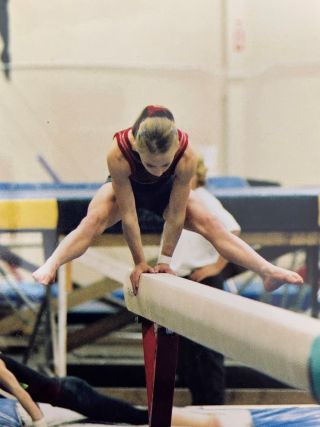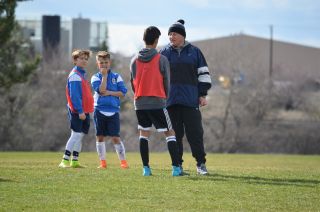Gaslighting
How Adults Gaslight Children
Asking silencing questions, lowering a child's worth, and more.
Posted January 11, 2023 Reviewed by Vanessa Lancaster
Key points
- Children are trained to respect and obey adults; thus, they are easy prey for those who want to manipulate them.
- Teaching children about gaslighting and how to recognize it can help protect them.
- Teach children that their age, inexperience, and dependence make them vulnerable to adults in positions of trust and authority.

A colleague of mine, Amelia Cline, is a survivor of psychological abuse by coaches when she was an elite athlete in childhood. Amelia and I are on a task force striving with others to establish better protections for athletes and, ultimately, all children and youth. Amelia exited gymnastics in her teen years, recognizing that it put her physical safety and mental health at risk. She went on to pursue law and sought justice for those maltreated like herself.
Recently she posted the picture at left on Twitter and noted for an audience of advocates battling for "Safe Sport" in Canada that she was daily told by her coaches at this time that she was “fat.”
Study the picture. Amelia is the epitome of leanness, power, and sculpted musculature. Fat? Even as a developing teenage girl, any amount of fat on her body would be no business for a coach to mention unless he or she was a medical doctor and the “fat” was putting this young girl at risk for illness.
My immediate reaction to her tweet was to say how wrong it is for adults to “gaslight” children. Adult-to-adult gaslighting is harmful enough. When there is a massive power imbalance, such as coach-to-child-athlete and the coach uses gaslighting, the harm is exponentially worse.
According to this website, gaslighting is "an insidious form of manipulation and psychological control. Victims of gaslighting are deliberately and systematically fed false information that leads them to question what they know to be true, often about themselves. They may end up doubting their memory, their perception, and even their sanity. Over time, a gaslighter’s manipulations can grow more complex and potent, making it increasingly difficult for the victim to see the truth." (Gaslighting was such a sought-after term in 2022 that Merriam-Webster named it its word of the year.)
As a lawyer, Amelia was shocked. She had never thought of what was done to her as “gaslighting.” She was well aware that her coaches had been abusive but recognizing the daily deceit by adults in positions of trust and authority, who distorted her perception of reality and selfhood, was shocking.
Amelia recognized just how much these coaches sought to have coercive control over her and the other athletes. It’s an immense power to control a child’s sense of reality and selfhood. This is why psychologist, author, and gaslighting expert Robin Stern states that the impact of gaslighting “can be soul-destroying.”
Gaslighting Can Also Be Brain-Destroying
One of the brain’s key roles is to make sense of incoming data from inside the body and from the outside world via the senses. If an individual is extremely muscular and fit, lacks any body fat, and is told he or she is “overweight,” her brain becomes confused. As Michael Merzenich and I have discussed at length, the brain struggles to do its critical work, which is to “answer the question.”
Am I fit or out of shape? Is my body covered in high-performing muscles, visible to the naked eye, or am I covered in too much fat for an elite athlete? Amelia’s gaslit brain could not answer these questions.
It’s hardly surprising that when a person is lied to, offered a false bill of goods, or exposed to a fraudulent reality, they experience “confusion, loss of confidence and self-esteem, and doubts concerning their own emotional or mental stability.”
The role of the lungs is to bring breath into the body; the heart circulates blood; the brain deciphers reality. One definition of mental illness is when reality becomes distorted, and divorced from what others see, feel, and experience. Gaslighting, then, impacts the brain in serious, harmful ways. Body dysmorphic disorder would be a reasonable response to gaslighting coaches.

Educating Children and Youth About Adult Gaslighting
1. Teach children to understand that simply by their age, inexperience, and dependence on adults, they are vulnerable, especially when the adult is in a position of trust and authority. They need to know that most adults are safe, but some are dangerous.
2. Gaslighting is a form of what psychiatrist Alice Miller calls “poisonous pedagogy.” Children should watch out for adults who use “You are X” statements, especially when they are put-downs disguised as ways to help the child: “You are stupid.” “You are irresponsible.” “You are lazy.” “You are fat.” The adult reinforces failure in the child, which only establishes the child’s need for them. It is the parent, coach, or teacher who can make the child smart, responsible, hard-working, and slender.
3. Children should be taught to test how they are being treated by adults in positions of trust and authority in an arena with other adults. If parents do not understand power imbalance or gaslighting, kids should be instructed at schools, clubs, churches, and sports organizations aabout who are the right people with whom to speak.
Reality is not what an adult with power chooses. It is something that needs to be objectively measured. There needs to be fact-checking. Amelia’s coaches needed to supply a body mass index for teenage girls. If they wanted to tell her that, as an athlete, she would perform better with less body fat and more muscle, they needed to back that assessment with data. Just using a term like “fat” raises red flags of gaslighting because it is layered with moral overtones. It suggests that the coaches wanted their athletes to feel as if they were morally compromised, unable to resist eating, and not really committed to their sport. These are classic coaching abuse tactics. Athletes are benched and publicly shamed for “not trying.” Really? Most athletes play their sport because it’s their passion, so when you hear these kinds of vague put-downs, it suggests gaslighting is at play.
4. Watch out for adults who are two-faced—who act one way around other adults, such as parents, but change when they are alone with children. They might even mutter obscenities at children while smiling broadly for their adult audience. These kinds of contradictory behaviours are signs that reality is being manipulated.
Coaches who abuse—and, of course, this applies to teachers or parents as well—often have a two-faced way of behaving with children. They have chosen athletes or students whom they praise and make a show of caring about, which allows them to heighten the harmful gaslighting of their targets. Within a family, for example, one sibling may be privileged while another is put down.
5. Gaslighting adults may use rhetorical questions to make a child doubt themselves. If an adult asks threatening, insulting, or silencing questions that essentially remove a target's ability to respond, contribute, or assert their own experience and reality, it could be a sign of gaslighting.
It’s unfortunate that gaslighting has become so prominent that it was the 2022 word of the year. Let’s change that in 2023 and promote words like “skepticism,” “critical-thinking,” “fact-check,” “research,” “evidence-based,” “child advocacy,” “education,” “awareness,” “independence,” and “equity."
Facebook image: SeventyFour/Shutterstock




